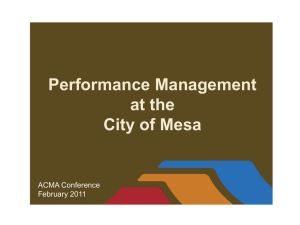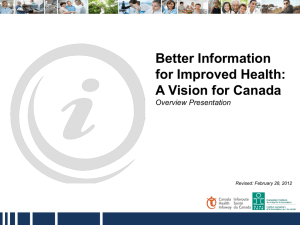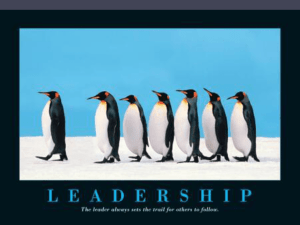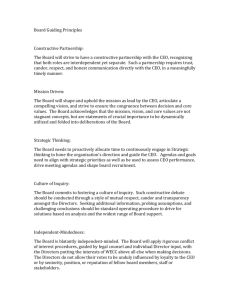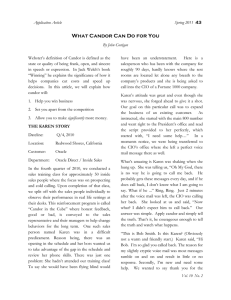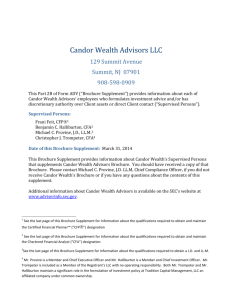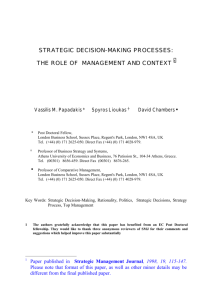On organizations
advertisement
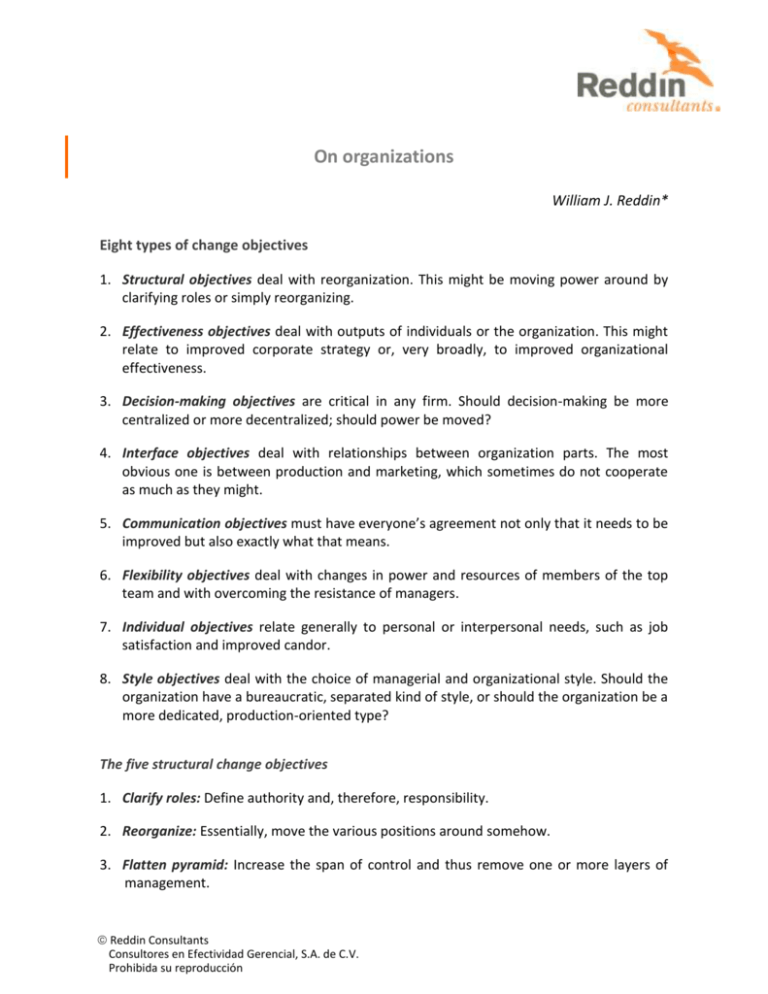
On organizations William J. Reddin* Eight types of change objectives 1. Structural objectives deal with reorganization. This might be moving power around by clarifying roles or simply reorganizing. 2. Effectiveness objectives deal with outputs of individuals or the organization. This might relate to improved corporate strategy or, very broadly, to improved organizational effectiveness. 3. Decision-making objectives are critical in any firm. Should decision-making be more centralized or more decentralized; should power be moved? 4. Interface objectives deal with relationships between organization parts. The most obvious one is between production and marketing, which sometimes do not cooperate as much as they might. 5. Communication objectives must have everyone’s agreement not only that it needs to be improved but also exactly what that means. 6. Flexibility objectives deal with changes in power and resources of members of the top team and with overcoming the resistance of managers. 7. Individual objectives relate generally to personal or interpersonal needs, such as job satisfaction and improved candor. 8. Style objectives deal with the choice of managerial and organizational style. Should the organization have a bureaucratic, separated kind of style, or should the organization be a more dedicated, production-oriented type? The five structural change objectives 1. Clarify roles: Define authority and, therefore, responsibility. 2. Reorganize: Essentially, move the various positions around somehow. 3. Flatten pyramid: Increase the span of control and thus remove one or more layers of management. Reddin Consultants Consultores en Efectividad Gerencial, S.A. de C.V. Prohibida su reproducción 4. Add Layer of management: This objective is often necessary when a company has grown by acquisition and the CEO finds 20 units reporting directly to the position. Clearly, there is a need for an assistant-CEO level. 5. Remove layer of management: As organizations grow, layers of management are often added quite unconsciously. Removing a layer of management does not apply simply to CEO and assistant CEO; it can apply equally well to supervisor and assistant supervisor. The five effectiveness change objectives 1. Improve organizational effectiveness: This broad objective can easily be measured by lower costs or improved service to clients. 2. Improve managerial effectiveness: Sometimes the change should be based on the individual manager rather than the organization as a whole. 3. Improve profit planning: If the organization is well structured and the managers reasonably motivated, the problem may be that they do not have a good planning cycle and that they do not have sharp pencils or spend time planning. 4. Introduce or improve management by objectives (MBO): This objective requires a wellplanned introduction or a regeneration of an MBO that did not work as well as was expected. 5. Improve corporate strategy: Ask the fundamental question: what business are we in? This is more than sales plans for one or two years. The five decision-making change objectives 1. Improve teamwork: Make more decisions on a group basis and emphasize the quality of the decision and the team commitment to it. This means more than improving relationships orientation. 2. Introduce participative management: This objective is problematic because some people think it means lower levels getting more involved in their work directly, while others think it means lower levels getting involved more in the senior levels of work. 3. Move decision-making downward: Many organizations talk about the desirability of doing this, but use such general terms as “decentralize”, “participation”, and “delegation”. However, “move decision making downward” is probably better than all of these because it states quite clearly what is intended. 4. Centralize: This broad objective can be made specific by the measurement methods attached to it. One can centralize some things, while leaving many other things not centralized. 2 5. Improve problem-solving climate: Improve the quality of decisions and the commitment to them solely by using more group methods and a greater degree of candor. The five interface-change objectives 1. Optimize the system: Organizations consist of units, or positions and aggregates of positions. Sometimes the units do not connect well with each other. In short, the interfaces do not run. Optimizing the system means getting the organization to work as a whole rather than getting the individual units or positions to improve their own effectiveness alone. 2. Improve horizontal communication: The most important communication problems can be horizontal, rather than the more commonly perceived vertical ones. 3. Improve inter-functional cooperation: There may be some specific functions, often production or marketing, that do not cooperate as well as they might. 4. Improve HQ-field relationships: Sometimes level A does not work well with level B. 5. Facilitate a merger: Address not only the financial problems but also the human ones. Often a merger results in a combined balance sheet but no real combination of effort. The five communication change objectives 1. Improve upward communication: Sometimes those at the top are not listening enough to those at the bottom. 2. Improve downward communication: Some senior managers think that this is always the problem. 3. Increase output of new ideas: Essentially, this is creativity, but it leads to better measurement methods than the term creativity might. 4. Increase use of new ideas: Many organizations have a very high output of new ideas, but for one reason or another they do not seem to be able to apply them. In that case this objective would be better than increasing the number of ideas; it would be much better to use the ones they have already. 5. Create greater autonomy: This means less inter-unit communication. Sometimes organizations are composed of parts that should not be together. Then great effort is spent on making the parts all work together, when in fact a different organizational structure should be created. 3 The five flexibility change objectives 1. Improve organizational flexibility: Make the organization respond better to external forces such as competition, government legislation, or new technology. Some organizations grow old too soon. They lose their power to adapt. 2. Improve manager flexibility: In some organizations particularly at middle management level, managers tend to increase their resistance and lower their flexibility. Top management wants to introduce a change but finds it is resisted. The easiest way to unfreeze middle managers is to send them to a one-week seminar. 3. Revitalize management: Get managers to rethink what they are doing. 4. Improve marketing orientation: Get the organization to think more of the market than of their own production system. 5. Facilitate system introduction: It is quite common for a new budgeting system, a new management information system, or a new computer system to be introduced with little thought of the human side. The five individual change objectives 1. Improve climate: Each organization has a climate, or culture. It amounts to “the way we do things around here”. 2. Improve candor: In some organizations people do not talk to other people about the right things often enough. 3. Improve job satisfaction: Arrange the situation so the individual whistles on the way to work rather than on the way home. 4. Serve individual needs: Some organizations want to do a better job of integrating the needs of the individual with the needs of the organization. Sometimes this is very difficult, but sometimes it can be done. 5. Increase individual autonomy: This can relate to such things as job enrichment. In essence it means letting the individual get on with it without being told as much as before. The five style change objectives 1. Increase separated managing: Increase emphasis on systems orientation and procedures. 2. Increase related managing: Increase emphasis on people. 4 3. Increase dedicated managing: Increase emphasis on getting the work done with reference to cost and quality. 4. Increase integrated managing: Increase emphasis on both people and work. 5. Increase matrix managing: Increase emphasis on designing the organization around project teams rather than around strict functional areas. Taken from the book: “The Smart Manager’s Book of Lists”. W.J. Reddin, Lake Publishing Company, pp. 264-269. 5

